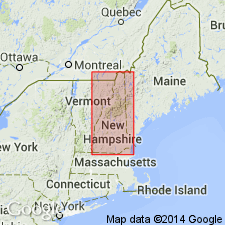
- Usage in publication:
-
- Frontenac Formation
- Modifications:
-
- Overview
- AAPG geologic province:
-
- New England province
Summary:
The Frontenac, since its naming, has been a subject of disagreement concerning its lithologic components, stratigraphic position, and structural presentation. The author and his colleagues (Bothner, Pollock, and Moench) consider the Frontenac to be Silurian and to lie beneath the Seboomook Group. Canadian geologists reverse the stratigraphic order and place the Frontenac in the Devonian and above units correlated with the Seboomook. The formation is informally divided into lower and upper portions. In most exposures the lower portion consists of thickly bedded, light bluish-gray to greenish gray, fine- to medium-grained, quartzofeldspathic, variably calcareous wacke. Wacke beds are typically interbedded with thinly bedded, dark gray mudstone slate. The upper portion, similar in bedding and composition to the lower portion, is generally non-calcareous and lacks, for the most part, the volcanic and hypabyssal intrusive rocks. Underlies Late Silurian and Early Devonian Ironbound Mountain Formation.
Source: GNU records (USGS DDS-6; Reston GNULEX).

- Usage in publication:
-
- Frontenac Formation*
- Modifications:
-
- Revised
- Areal extent
- Age modified
- Geochronologic dating
- AAPG geologic province:
-
- New England province
Summary:
In belt that includes type area, Frontenac Formation is divided into predominantly sedimentary facies, mixed sedimentary and volcanic facies, proximal bimodal volcanic facies, and basalt lenses (includes rocks mapped as Canada Falls Member of Frontenac by Marvinney (1986), a name not used on this map). Includes most sedimentary and volcanic rocks originally assigned to Frontenac in Frontenac Co., QUE, by McGerrigle (1935) and Marleau (1968), and in Second Connecticut Lake, ME 15-min quad by Green (1968). Previously mapped as part of Dixville Formation in Arnold Pond, ME, 15-min quad (Harwood, 1969, 1973); as parts of Gile Mountain and Kidderville Formations in Dixville, NH, 15-min quad (Hatch (1963); and as formation of Clinton and melange of Chesham (except for its euxinic metashale) in Quebec by St. Julien and Slivitsky (1987). In this report, this belt is extended into area of Guildhall and Percy 15-min quads, VT and NH. Western facies of Frontenac is composed of rocks similar to those of eastern facies, but lacks volcanic rocks. Previously mapped as part of Gile Mountain Formation in Dixville quad by Hatch (1963) and in Averill, VT, 15-min quad by (Myers, 1964). Western facies includes separately mapped calcareous member (previously mapped as Waits River Formation in Dixville quad by Hatch, 1963), hornblende schist lenses, graded-bedded graywacke member, and shale and arenite member. Formation is unfossiliferous, but was considered Early Devonian by Boucot (1961); St. Julien and Slivitsky (1987) assigned a Cambrian and Ordovician age to rocks now mapped as Frontenac. Age here changed to Silurian (Wenlockian, Ludlovian, and Pridolian? per time scale of Harland and others (1989)) on basis of 1) its conformable stratigraphic position below Lower Devonian Ironbound Mountain Formation, and 2) Silurian U-Pb zircon ages of volcanic rocks within Frontenac (432+/-10 Ma from Aleinikoff and Moench (1985) recalculated by Aleinikoff (this report); 418+/-4 Ma from Lyons and others (1983) recalculated by Aleinikoff (this report); and less than 430 Ma from Aleinikoff and Moench (1985)). Volcanic rock are probably comagmatic with East Inlet pluton. Recent mapping in Guildhall quad indicates Frontenac and Perry Mountain Formation are lateral facies of one another; Silurian U-Pb ages of 412+/-2 Ma and 414+/-4 Ma for Perry Mountain Formation (Aleinikoff, this report) also support Silurian age assignment for Frontenac. In western facies (Indian Stream, NH, 15-min quad) metagraywacke beds in the shale and arenite member hosting cobbles that contain possible fungal remains are probably no older than late Wenlockian (Hueber and others, 1990); however, a Devonian age is not ruled out.
Source: GNU records (USGS DDS-6; Reston GNULEX).

- Usage in publication:
-
- Frontenac Formation*
- Modifications:
-
- Overview
- Areal extent
- Age modified
- Geochronologic dating
- AAPG geologic province:
-
- New England province
Summary:
Used as Frontenac Formation. Frontenac was named by McGerrigle (1935) in Quebec and has been mapped by St. Julien and Slivitsky (1987) in Quebec and by Marvinney (1982, 1986) and Pollock (1985) in northwestern ME. Stratigraphically underlies Compton Formation of Quebec (equivalent to Gile Mountain Formation of NH) and Ironbound Mountain Formation in ME and NH. Age is changed to Silurian(?). Felsic metatuff in Frontenac yielded U/Pb age of 432+/-10 Ma (J.N. Aleinikoff, oral commun., 1985). Frontenac has been recognized in NH in border area near Customs Station by W.A. Bothner and R.H. Moench (1992, unpub. data) during field mapping in Sherbrooke-Lewiston 1:250,000 quad, ME, NH, and VT. Generally consists of interbedded thick feldspathic wackes, tan and green slates, and minor calcareous lenses. Also separately mapped are massive tan- or brown-weathering calcite-ankerite-muscovite granofels and interbedded gray metapelite (probably equivalent to Waits River Formation of VT). Report includes geologic map, cross sections, correlation chart, and four 1:500,000-scale derivative maps. [Reviewer's Note: During map edit, the issue of age of Frontenac was raised for purposes of constructing correlation chart. In letter to Susan Tufts-Moore (map editor) from John Lyons (10/6/93), Lyons states: "...no one knows even an approximate age of the unfossiliferous Frontenac Formation and any age is conjectural....Perhaps a more exact designation would be Silurian(?).]
Source: GNU records (USGS DDS-6; Reston GNULEX).
For more information, please contact Nancy Stamm, Geologic Names Committee Secretary.
Asterisk (*) indicates published by U.S. Geological Survey authors.
"No current usage" (†) implies that a name has been abandoned or has fallen into disuse. Former usage and, if known, replacement name given in parentheses ( ).
Slash (/) indicates name conflicts with nomenclatural guidelines (CSN, 1933; ACSN, 1961, 1970; NACSN, 1983, 2005, 2021). May be explained within brackets ([ ]).

